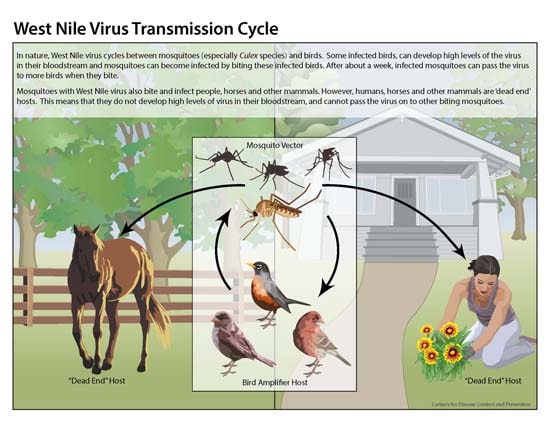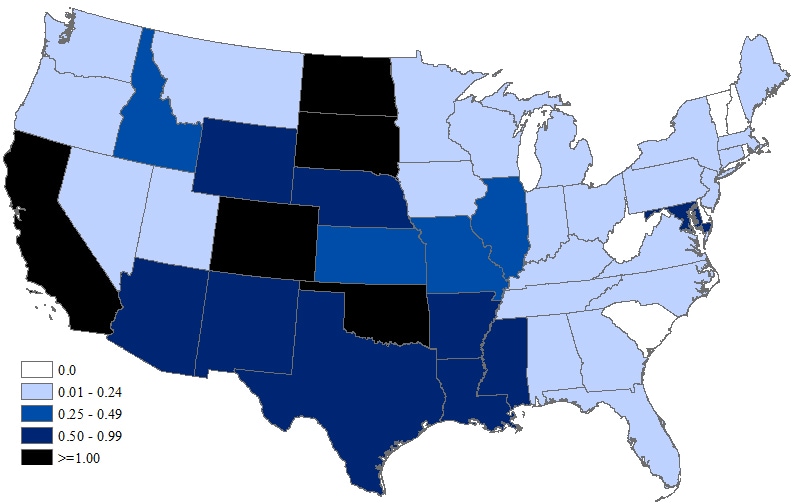West Nile Virus
What is West Nile Virus (WNV)?
The West Nile virus (WNV) is a member of the flavivirus genus which is from the family Flaviviridae. The virus causes a neurological disease that in some cases becomes fatal. WNV is commonly found in Africa, Europe, the Middle East, North America and West Asia. It was introduced to the United States in 1999.
Hosts, Vectors, and Route of Transmission
The original hosts of the virus are birds. When mosquitos feed on birds infected with WNV, they become a vector (they carry the virus but are not affected by it themselves). Vector mosquitos then feed on other animals (commonly horses and humans) and can infect them with WNV. There have been no reports, however, that the virus can be shed from horses or humans onto other organisms, including those within the same species.

Retrieved from the CDC: http://www.cdc.gov/westnile/transmission/index.html
Clinical Signs and Prognosis
80% of those infected with WNV will be asymptomatic, however the other 20% do develop West Nile fever or severe disease. Additional signs associated with the fever are headaches, body aches, lethargy, and vomiting. About 1 in 150 people infected with WNV will develop a more severe form of the disease, which could present as West Nile encephalitis or meningitis or West Nile poliomyelitis. Signs of these conditions include headache, high fever, neck stiffness, disorientation, coma, tremors, convulsions, muscle weakness, and paralysis. There is no distinct treatment other than supportive care, and it does occasionally result in fatalities.
References
Centers for Disease Control and Prevention (2015, February 12). Transmission. Retrieved from http://www.cdc.gov/westnile/transmission/index.html.
World Health Organization (2011, July). West Nile virus. Retrieved from http://www.who.int/mediacentre/factsheets/fs354/en/.
Quick Facts from WHO (World Health Organization)
- West Nile virus can cause fatal neurological disease in humans.
- However, approximately 80% of people who are infected will not show any symptoms.
- West Nile virus is mainly transmitted to people through the bites of infected mosquitoes.
- The virus can cause severe disease and death in horses.
- Vaccines are available for use in horses, but not yet available for people.
- Birds are the natural hosts of West Nile virus.
Reference
World Health Organization (2011, July). West Nile virus. Retrieved from http://www.who.int/mediacentre/factsheets/fs354/en/.
West Nile Virus Neuroinvasive Disease Incidence by State

"This map shows the incidence of human West Nile virus neuroinvasive disease (e.g., meningitis, encephalitis, or acute flaccid paralysis) by state for 2015 with shading ranging from 0.01‐0.24, 0.25‐0.49, 0.50‐0.99, and greater than 1.00 per 100,000 population."
Reference
Centers for Disease Control and Prevention (2016, January 12). West Nile Virus Neuroinvasive Disease Incidence by State – United States, 2015. Retrieved from http://www.cdc.gov/westnile/statsmaps/preliminarymapsdata/incidencestatedate.html.
Why do veterinarian's care?
Aside from humans, horses are one of the other very common hosts of WNV. Veterinarians should be aware of what to look out for and how to respond appropriately in the event they encounter a case of WNV. Like in humans, most horses infected with WNV will be asymptomatic, however it can also result in neurologic disease, including fatal encephalomyelitis. Treatment, as in humans, is mainly supportive care. There is a vaccine available for use in horses to help prevent contraction of West Nile disease, and thus far it has been viewed as effective. See this article from the Veterinary Research journal for more information about the effectiveness of the vaccine.
From a "One Health" perspective, veterinarians are also important in the handling of West Nile because of the need to report cases of WNV they encounter. Because humans and horses are both "dead-end" hosts, if there are horses infected in an area, it is likely that humans will also be infected. By reporting cases of WNV in horses to the appropriate parties, veterinarians will help to create awareness in the area and thus likely help prevent further cases from developing.
References
World Health Organization (2011, July). West Nile virus. Retrieved from http://www.who.int/mediacentre/factsheets/fs354/en/.
Related Links
-
Statistics & Maps - WNVUseful map of West Nile incidences. You can specify the state, the year, and infected individuals (both human and veterinary cases).
-
Mosquito ControlFor those interested in mosquitoes as the vector of WNV